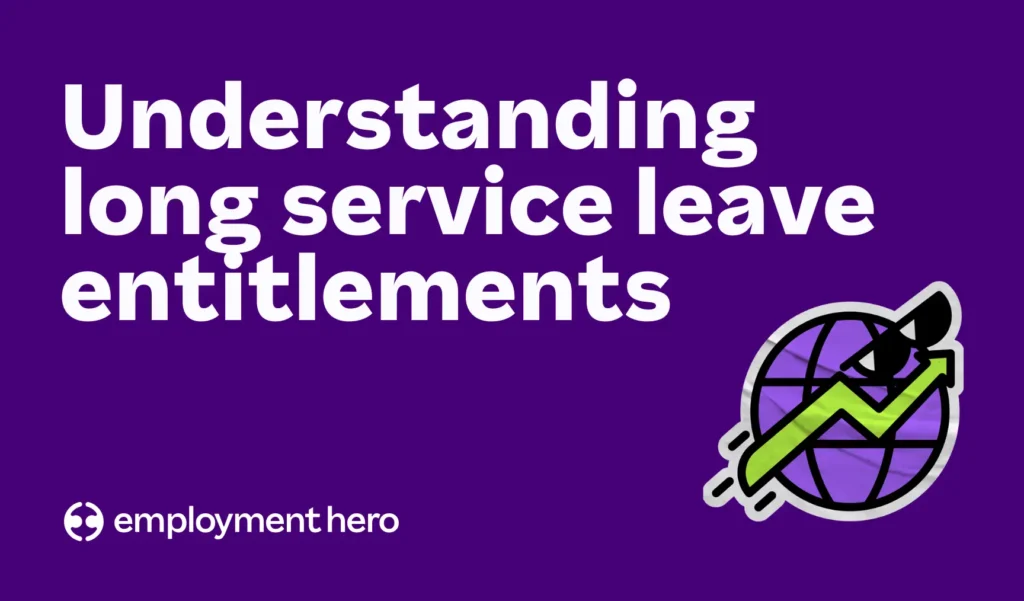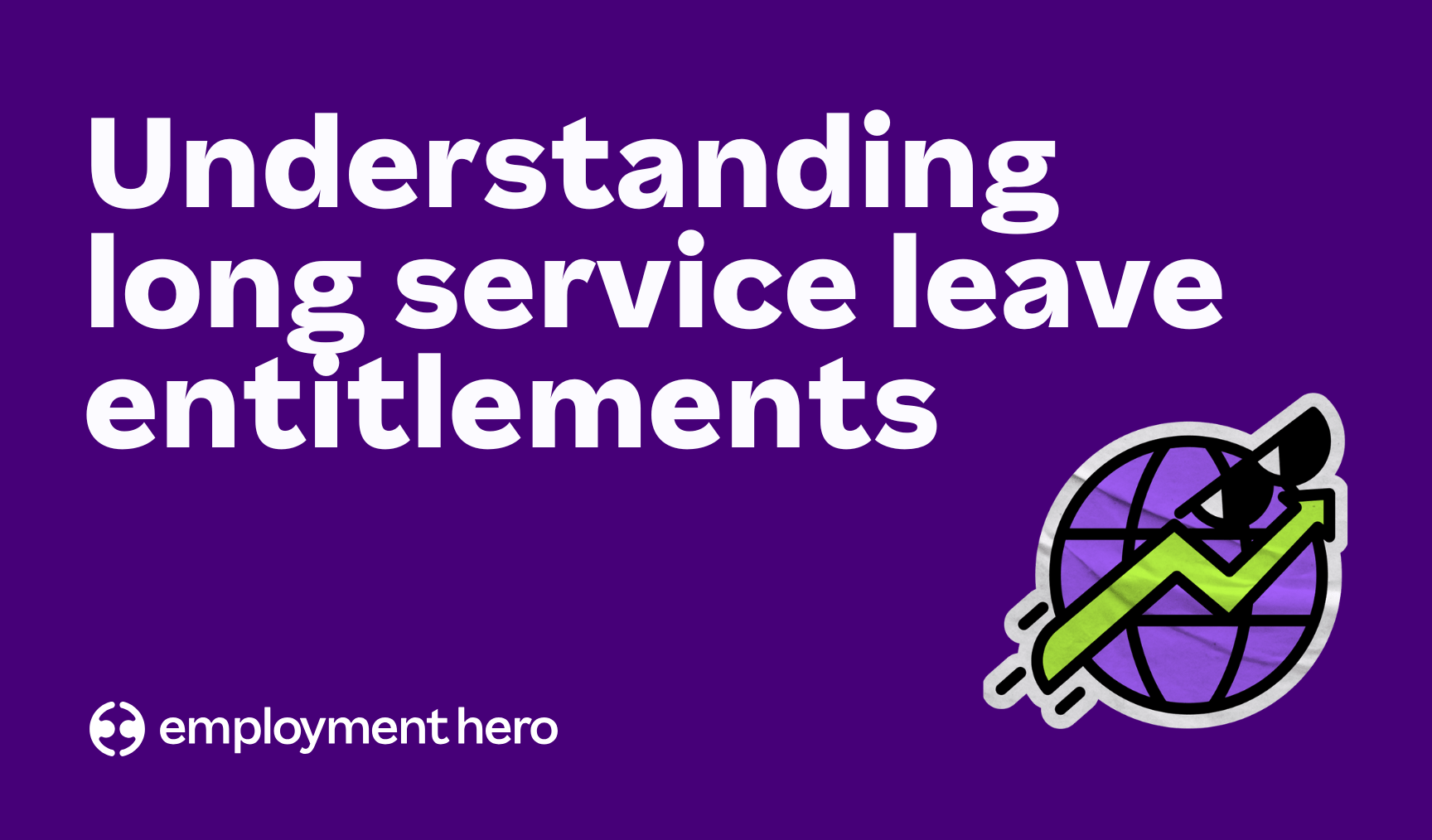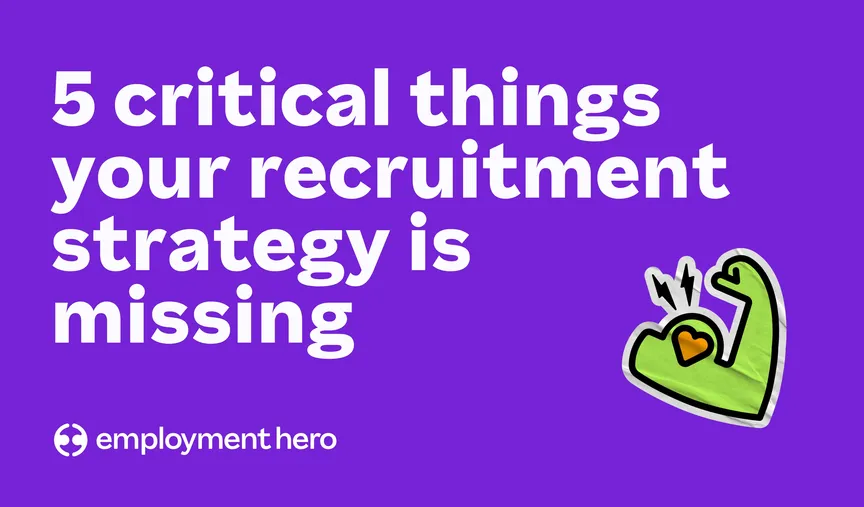Guide to long service leave entitlements in Australia
Understanding long service leave entitlements can be challenging. We share everything employers need to know about managing it.

Contents
Guide to long service leave entitlements in Australia
Most employees in Australia start dreaming of long service leave (LSL) early in their career. A trip around Australia, jetsetting abroad or getting serious about a hobby… it’s a well-earned reward for years of loyalty.
And although the thought of accessing long service leave is an exciting one for employees, understanding the legal obligations of long service leave as an employer can be complex and confusing.
Does every state and territory in Australia share the same rules and regulations around long service leave? Who is entitled to long service leave and when? Does long service leave transfer across employers? Can you choose to cash out long service leave?
These are just some of the questions you might have when navigating your employer obligations.
We’ve got all the answers to these questions and more in this guide, so employers can navigate it with confidence and clarity.
Disclaimer: The information in this article is relevant as at 16 July 2025, and has been prepared by Employment Hero Pty Ltd ABN (11 160 047 709) (Employment Hero). The views expressed herein are general information only and are provided in good faith to assist employers and their employees. The Information is based on data supplied by third parties. While such data is believed to be accurate, it has not been independently verified and no warranties are given that it is complete, accurate, up to date or fit for the purpose for which it is required. Employment Hero does not accept responsibility for any inaccuracy in such data and is not liable for any loss or damages arising either directly or indirectly as a result of reliance on, use of or inability to use any information provided in this article.

What is long service leave (LSL)?
Long service leave is a type of paid leave that employees are entitled to after working for their employer for a significant period of time.
The period of time required before an employee is entitled to long service leave varies from state to state, and the amount of paid leave also varies.
What’s the difference between long service leave and annual leave?
Permanent employees are entitled to a set amount of paid annual leave per year, as outlined within the Fair Work Act 2009 (Cth) or their relevant modern award.
For most employees, this entitlement is four weeks of annual leave per year (although this can vary depending on their award or if they are classified as a ‘shiftworker’ under Fair Work Act).
Annual leave accrues progressively throughout the year, depending on the employee’s ordinary hours of work. An employee does not need to complete a certain ‘qualifying period’ before being able to access their accrued annual leave balance, and they’ll be able to start using these entitlements as soon as they have accrued the relevant leave they wish to take.
All permanent employees are entitled to annual leave, however, casual employees don’t receive this entitlement.
On the other hand, long service leave is a specific leave for long standing employees after they have completed a certain period of service with their employer. Each state or territory will set out exactly how long an employee must work for before having access to any long service leave entitlement, which we’ve included below.
This entitlement is not immediately available for an employee to take, but will only become accessible once they have completed the necessary period of service.
All employees have access to paid long service leave, including eligible casual staff as set by state legislation.
Who is entitled to long service leave?
Casual, part-time and full-time employees are entitled to long service leave. Long service leave applies to any employee who has worked for the required period of time for the same employer.
Individuals who are exempt from long service leave entitlement
Genuine independent contractors are not eligible for long service leave. Employees employed by the Commonwealth Government or those working for local government may also have a different long service leave entitlement.
Employees who have also completed the majority of their continuous service overseas or interstate, may have different eligibility requirements for their relevant long service leave entitlement.
Finally, employees who have not completed the relevant qualifying period of continuous service (or have broken their continuous service) as defined within their state or territory, will not be eligible for long service leave. For more details, visit the Fair Work website.
What about portable long service leave?
In some industries, as well as the “regular” long service leave entitlement explained in this guide, there are portable long service leave schemes.
These operate in industries where employees often change employers and so employees do not usually have enough continuous service to be eligible for long service leave.
Portable long service leave schemes generally operate so that an employee can be entitled to long service leave regardless of how many times they change employer, so long as they remain in the industry.
The scheme is funded by employers paying a levy into a central fund and employees are paid from the scheme when they take leave, rather than paid by the employer.
In some circumstances the scheme applies to contractors too.
Different portable long service leave schemes operate in different states and territories, usually in the building and construction industry, security, cleaning and/or community services sectors. You can view a list of the different schemes at the end of our in-depth blog here.

Are long service leave entitlements the same across Australia?
Long service leave entitlements vary depending on which state or territory you work in. Entitlements may also vary where a federal ‘pre-modern’ award contains long service leave entitlements and this would have covered an employer and their employees before 1 January 2010. In this case, the long service leave entitlements will come from the pre-modern award.
This does not mean that an employee must have been employed before 2010 in order to get long service leave entitlements from a pre-modern award. It means that if you take the circumstances of the employee as of today’s date, and “suppose” they were actually working pre-2010, would they have been covered by a pre-modern award with a long service leave provision?
If the answer is “yes”, then the pre-modern award long service leave provision will apply instead of the regular state or territory rules. View the list of pre-modern awards with long service leave provisions here.
Most of these pre-modern awards only cover the specific named employers listed in the award, and the vast majority of employees will get their long service leave, based on state or territory regulations.
Long service leave in NSW
In NSW, most casual, part-time and full-time employees are entitled to 2 months (8.67 weeks) of paid leave after 10 years of continuous service with their employer. Employees are entitled to an additional one month of leave for each additional 5 years of service thereafter.
How leave is paid differs depending on whether the employee has fixed hours, fluctuating hours or is paid based on ‘commission only’ or ‘piece work’.
Generally, for employees in NSW who work fixed hours and are paid wholly in relation to an ordinary rate of pay, their leave will be paid at the workers ordinary rate at the time the leave is taken, or their average weekly ordinary pay earned during the previous 5 year period where this is greater.
The general principle for payment of long service leave in NSW is that this is paid at their ordinary rate, but employees should not be penalised for recent dips in earnings or worked hours, hence this approach. These calculations vary for employees that do not have fixed hours or an ordinary rate of pay.
Are employees entitled to long service leave before completing 10 years of service in NSW?
Some employees may be entitled to long service leave before completing 10 years of service. This applies to circumstances where a worker resigns after 5 years of service (but less than 10 years) due to ‘incapacity, illness, or domestic or other pressing necessity’. This means they may be entitled to pro rata long service leave payment.
Additionally, pro rata long service leave is also available after 5 years of service if the employer terminates the employment contract for any reason other than ‘serious misconduct’, or if the employee passes away. However, employees with less than 5 years of service will not have any entitlement to long service leave in any circumstance.
Long service leave is based on the employees ‘continuous service’ with their employer. Most periods of work and paid leave will count towards this. However, there are some periods that may not count towards the employees continuous service, but will not constitute a break in their service, such as unpaid parental leave.
You can read more about NSW Long Service Leave on the Industrial Relations website.
Long service leave in Victoria
Long service leave is available to full-time, part-time, casual, seasonal and fixed-term employees in Victoria. Employees are eligible for long service leave after a period of 7 years service. The leave will accrue at a rate of one week for every 60 weeks of continuous service (which will be around 0.866 of a week each year meaning the entitlement at 7 years will be 6.0667 weeks).
Employees can take their long service leave in advance, if their employer agrees. Employees can also double their long service leave period, by taking this at half pay, if their employer agrees to such a request.
Similar to NSW, most periods of paid leave will count towards continuous service. However in Victoria, unpaid leave (including unpaid parental leave) up to 52 weeks will count towards an employee’s period of employment. Unpaid leave in excess of this may continue to count towards their service in specific circumstances.
You can read more about long service leave in Victoria on the Victorian Government website.
Long service leave in Tasmania
Most employees, of all contract types, are entitled to 8⅔ weeks of long service leave after 10 years of employment in Tasmania. Similar to NSW, employees are then entitled to an additional 4⅓ weeks of long service leave for each 5 years of service.
Most paid and unpaid leave does not interrupt the accrual of long service leave, including any leave required to attend training or events run by Tasmanian State Training Authority or similar committees. However, these periods may not count towards the employee’s continuous service with the employer. Specifically, unpaid parental leave does not break an employee’s ‘continuous employment’, but will not count towards their total service for long service leave purposes.
Pro rata long service arrangements are possible once an employee has worked for more than 7 years, but only in specific circumstances. These circumstances include where the employee is terminated for any reason other than serious or wilful misconduct or dies. It also includes where the employee resigns due to illness, incapacity, reaching retirement age, domestic or pressing necessity.
You can read more about long service leave in Tasmania on the WorkSafe website here.
Long service leave in Queensland
In Queensland, employees are entitled to 8.6667 weeks of long service leave after 10 years of continuous service. After a further 5 years of employment, employees are entitled to another 4.3333 weeks of long service leave.
Those who are a full-time, part-time or casual employee are all eligible, as long as there is no more than 3 months break between periods of employment for the same employer.
Pro rata arrangements are possible after 7 years of service when resigning because of illness, incapacity, death, “domestic or other pressing necessity” or termination by employer (except because of conduct, capacity, or performance).
Paid leave does not impact accrual of long service leave, including paid parental leave. Additionally, unpaid leave, including parental leave, does not break the employee’s service, but will not count towards the calculation of continuous service.
You can read about Queensland’s long service leave regulations on the Business Queensland website.
Long service leave in Western Australia
In Western Australia, full-time, part-time, casual and seasonal employees, as well as apprentices and trainees are entitled to long service leave after 10 years of continuous service. After 10 years, employees can access 8.667 weeks of paid leave and then an additional 4.333 every 5 years.
All paid leave counts toward accrual of long service leave. This includes parental leave. Most unpaid leave will not count towards continuous service, including unpaid parental leave.
In Western Australia, fly in, fly out (FIFO) employment is common. In this case, long service leave is typically accrued across all weeks of employment, including ‘off weeks’.
Pro rata long service leave is paid for service between 7 and 10 years where an employee resigns, is made redundant, dies or whose employer terminates their employment for any reason other than serious misconduct.
You can read more about long service leave in Western Australia on the Commerce WA website.
Long service leave in South Australia
In South Australia, those who are a full-time, part-time or casual employee are entitled to 13 weeks of long service leave after 10 years of service. Then, they accrue an additional 1.3 weeks of leave per year.
Employees are eligible for a pro rata long service arrangement if their employment ends between 7 and 10 years of employment, but not if their employment is terminated on the grounds of serious and wilful misconduct, or if they unlawfully terminate their employment, such as failure to give the required amount of notice upon termination.
In South Australia, all paid leave counts toward the accrual of long service leave. This includes paid sick leave and parental leave. However, leave paid by the government’s parental leave scheme does not count, nor does unpaid parental leave.
Learn more about long service leave in South Australia on the SafeWork SA website.
Long service leave in ACT
Full-time, part-time and casual employees in the ACT are entitled to 6.0667 weeks of long service leave after 7 years of service. Employees accrue a further 1.086 weeks of leave each year after this.
Continuous service will include most paid leave, periods of annual leave and during up to two weeks of leave taken for an illness or injury (paid or unpaid).
Employees are entitled to a pro rata long service arrangement after 5 years of service, in specific circumstances. These are when an employee resigns because of reaching minimum retirement age as set by any applicable modern award (or else if they are 65) or resignation due to illness, incapacity, death, domestic or pressing necessity. It will also be payable where there is termination by the employer unless it is for serious or wilful misconduct.
Learn more about long service leave in ACT on the WorkSafe ACT website.
Can employees cash out long service leave?
Each state or territory will have different rules around cashing out long service leave. For example, in ACT, Tasmania, South Australia and WA this is permitted subject to agreement between both parties, but it is not an option in NSW, Victoria, Northern Territory. In Queensland cashing out long service leave is only allowed where permitted by an award/ workplace agreement or by approval of the Queensland Industrial Relations Commissioner.
What happens to an employee’s accrued long service leave if their employment ends?
If the employee has been working for the employer for the relevant qualifying period (depending on their state or territory), they will be entitled to be paid their long service leave entitlements when their employment ends.
In certain circumstances, an employee may be entitled to a pro-rata payment for their long service leave if ending their employment period before becoming entitled to actually take the leave (see details above).
If the employee is moving to an associated business or is under a ‘portable long service scheme’ they may be able to transfer their long service leave or this may count towards their overall service even with a new employer.
Similarly, if business ownership changes, employees’ previous service for long service leave purposes will typically transfer to their new employer (subject to the rules of their state or territory legislation).
Do employers pay super while their employees are on long service leave?
Yes. Employees are entitled to super payments whilst on long service leave. Employees may not be entitled to such contributions if receiving a lump sum payment for their long service leave on termination.
Make sure these details are in your leave policy.
Can an employer refuse a long service leave request?
Each state and territory will have specific rules around how long service leave should be taken, and what agreement should be made between the employer and employee.
Generally, long service leave should be taken at a mutually agreeable time and there are quite limited circumstances where an employer could refuse for an employee to take their entitlements. This could include where it may not be practical to accommodate the request at that time due to reasonable business grounds.
However, employers should ensure to check their relevant state legislation and seek further professional guidance if uncertain on their obligations.
Managing your employer obligations with Employment Hero
Has all this talk of long service leave left you feeling overwhelmed? We don’t blame you, it’s some tricky business.
Thankfully Employment Hero is purpose-built to help you navigate entitlements like these and so much more. With in-built modern award interpretation, a powerful payroll engine and a 1500+ strong team of employment experts, our Employment Operating System can help you confidently manage all your employer obligations.
If you’re looking for additional help, our HR advisory service can help you with unique advice specific to your business. With a team of HR experts on hand who know the ins-and-outs of employment law, it means you can focus on the growth of your business rather than compliance.
With HR advisory, you can access HR and employment advice, compliance checks, plus approved tools and templates. HR Advisory is here to give you the confidence and peace of mind to manage your workforce, boost your compliance confidence and focus on what matters most – running a successful business.
If you’d like to learn more, get in touch with one of our business specialists today.
Related Resources
-
 Read more: Guide to long service leave entitlements in Australia
Read more: Guide to long service leave entitlements in AustraliaGuide to long service leave entitlements in Australia
Understanding long service leave entitlements can be challenging. We share everything employers need to know about managing it.
-
 Read more: The $124,000 Cashflow Crunch: Small and Medium Businesses (SMBs) at risk under proposed Payday Super Requirements
Read more: The $124,000 Cashflow Crunch: Small and Medium Businesses (SMBs) at risk under proposed Payday Super RequirementsThe $124,000 Cashflow Crunch: Small and Medium Businesses (SMBs) at risk under proposed Payday Super Requirements
New Employment Hero modelling and research shows businesses will need an extra $124,000 in working capital on average to meet…
-
 Read more: From hiring mismatch to SmartMatch: 5 critical things your recruitment strategy is missing
Read more: From hiring mismatch to SmartMatch: 5 critical things your recruitment strategy is missingFrom hiring mismatch to SmartMatch: 5 critical things your recruitment strategy is missing
We’ve wrapped up five critical things your recruitment strategy might be missing so you can feel confident in your hiring…



















